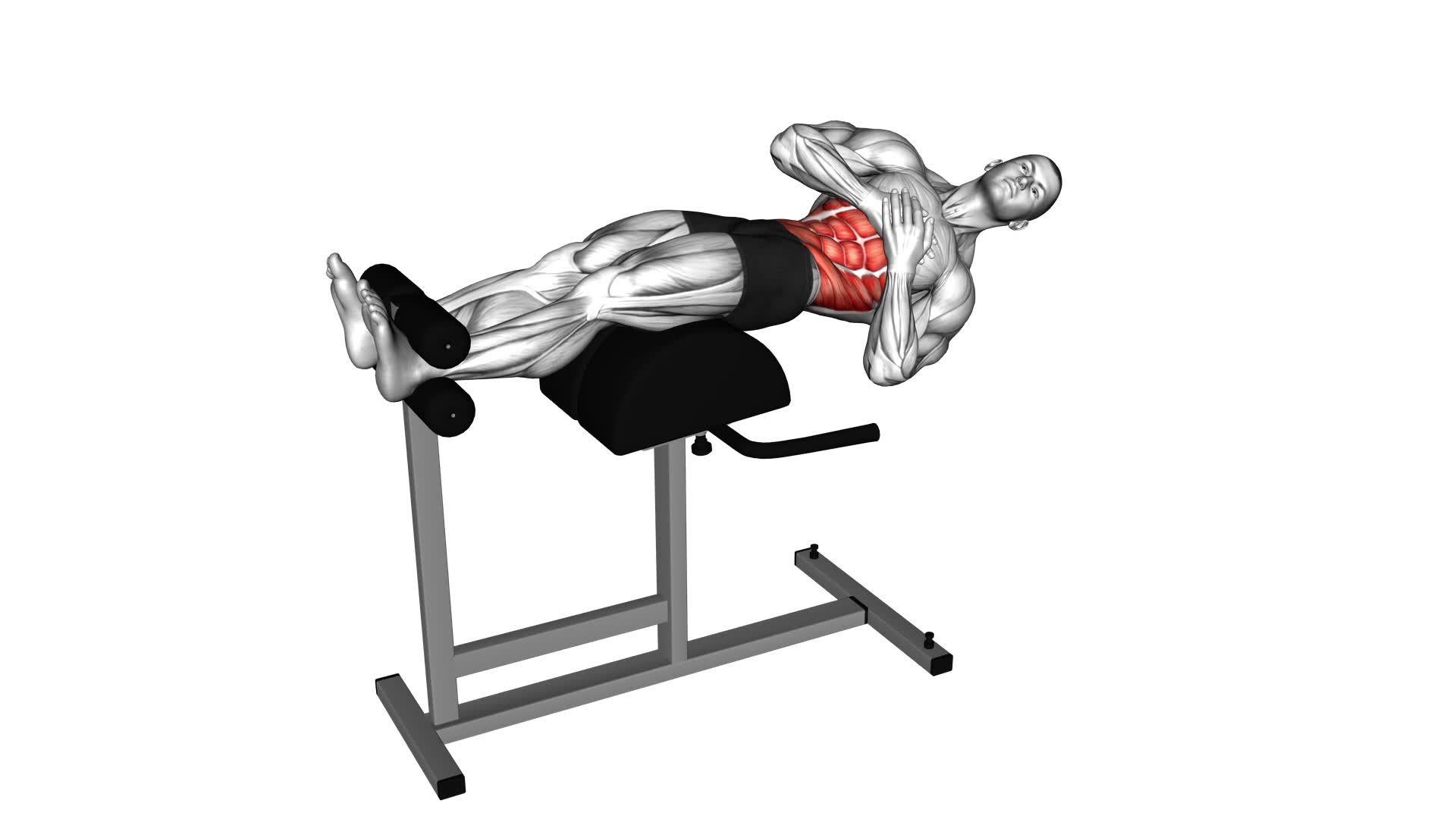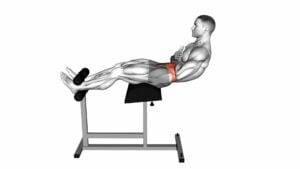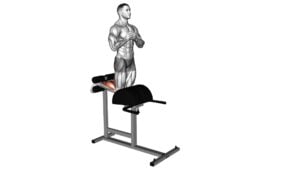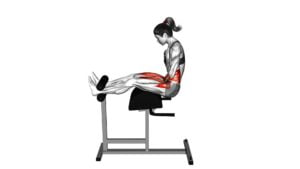Glute Ham Twist – Video Exercise Guide & Tips

Looking to target your glutes and hamstrings? Check out the Glute Ham Twist!
Watch This Exercise Video
This video exercise guide provides step-by-step instructions and expert tips to help you perform the move with proper form and technique.
Whether you're a beginner or advanced fitness enthusiast, you'll find modifications and progressions to suit your level.
Get ready to incorporate the Glute Ham Twist into your workout routine for maximum results!
Key Takeaways
- The Glute Ham Twist strengthens core muscles, particularly the obliques.
- Engaging the glute muscles for stabilization is an important aspect of the exercise.
- It improves lower body strength and power.
- The exercise enhances overall core strength and stability.
Benefits of the Glute Ham Twist
The Glute Ham Twist offers a variety of benefits for your lower back, core, and glute muscles. This exercise is highly effective in strengthening your core muscles, particularly your obliques. By twisting your torso while maintaining stability on the glute ham machine, you engage your core muscles in a unique way, promoting greater core strength and stability.
In addition to targeting your core, the Glute Ham Twist also works your glute muscles. As you twist your torso, you engage your glutes to stabilize your body, resulting in stronger glute muscles over time. This exercise can help to improve your overall lower body strength and power, which can be beneficial for various sports and activities.
There are also variations of the Glute Ham Twist that you can incorporate into your workout routine. By adding resistance bands or holding a weight plate, you can increase the intensity of the exercise and further challenge your muscles. These variations can help to target different muscle groups and add variety to your training.
Equipment and Setup for the Exercise
To perform the Glute Ham Twist effectively, it's essential to have the proper equipment and set it up correctly.
Select a glute ham developer machine that's sturdy and adjustable to accommodate your height and comfort level.
Make sure to set the footplate at a suitable distance and secure your feet firmly in the foot straps.
Following these guidelines will ensure a safe and effective workout.
Proper Equipment Selection
Before you begin the Glute Ham Twist exercise, make sure that you have selected the proper equipment and set it up correctly.
The first step is to choose the right equipment type for this exercise. You can use a glute ham developer or a GHD machine, which is specifically designed for targeting the glutes and hamstrings. Ensure that the equipment is in good condition and properly maintained to ensure safety during your workout. Check for any loose parts or damaged surfaces that could pose a risk.
Next, adjust the equipment to fit your body properly. Make sure the foot pads are at a comfortable height and securely locked in place. Take the time to set up the equipment correctly to ensure a safe and effective workout.
Setting up Correctly
To properly set up for the Glute Ham Twist exercise, ensure that you have selected the appropriate equipment and have it positioned correctly. Here are some steps to help you with the setup:
- Equipment selection:
- Choose a glute-ham developer machine or a stability ball.
- If using a stability ball, make sure it's inflated to the appropriate size and can support your body weight.
- Positioning:
- Place the glute-ham developer or stability ball in a clear space with enough room for your movements.
- If using a glute-ham developer, adjust the footplate and knee pads to fit your body.
- If using a stability ball, position it securely on the ground and ensure it won't roll or move during the exercise.
By following these setup guidelines, you can ensure a safe and effective Glute Ham Twist workout.
Proper Form and Technique for the Glute Ham Twist
To perform the Glute Ham Twist with proper form and technique, there are a few common mistakes you should avoid. These include:
- Rushing through the movement
- Using momentum instead of engaging your core
- Neglecting to maintain a neutral spine
Common Mistakes to Avoid
You should always be aware of the common mistakes to avoid when performing the Glute Ham Twist exercise to ensure proper form and technique. Here are some key points to keep in mind:
- Improper alignment: Make sure to maintain a neutral spine throughout the exercise. Avoid arching or rounding your back excessively.
- Lack of core engagement: Engage your core muscles by actively squeezing your abs and glutes during the movement. This will help stabilize your body and prevent any unnecessary strain on your lower back.
- Using momentum: Avoid using momentum to twist your body. Instead, focus on controlled and deliberate movements to maximize the effectiveness of the exercise.
- Neglecting breathing: Remember to breathe properly throughout the exercise. Inhale deeply as you twist, and exhale as you return to the starting position.
- Overextending the neck: Keep your neck in a neutral position to avoid straining it. Avoid looking up or down excessively during the exercise.
Benefits of Proper Technique
Maintaining proper form and technique during the Glute Ham Twist exercise enhances its effectiveness and reduces the risk of injury.
By performing the exercise with correct form, you can improve stability and prevent injuries. Proper technique ensures that you target the intended muscles, such as the glutes, hamstrings, and core, effectively. It also helps you maintain proper spinal alignment, reducing strain on your back.
By engaging the muscles properly, you can maximize the benefits of the exercise, such as increasing lower body strength and stability. Additionally, using proper form ensures that you perform the exercise in a controlled manner, minimizing the risk of sudden movements or jerking motions that could lead to injuries.
Now, let's move on to the next section and discuss common mistakes to avoid.
Common Mistakes to Avoid
Avoid falling into the trap of neglecting proper form during the Glute Ham Twist exercise. Common mistakes can hinder your progress and increase the risk of injury. Here are some key errors to watch out for:
- Using momentum: Swinging your body or using momentum to perform the twist takes away the focus from your glutes and hamstrings. Instead, engage your core and control the movement.
- Lack of control: Rushing through the exercise without proper control can lead to sloppy form and decreased effectiveness. Take your time and concentrate on maintaining proper technique throughout the entire range of motion.
- Dropping the hips: Allowing your hips to drop or sag during the twist puts unnecessary strain on your lower back. Keep your core engaged and maintain a straight line from your shoulders to your heels.
- Neglecting the twist: The glute ham twist involves both a hip extension and a rotational component. Make sure to fully rotate your torso and engage your obliques to get the most out of the exercise.
By avoiding these common mistakes and focusing on proper technique, you can maximize the benefits of the Glute Ham Twist exercise.
Now, let's explore modifications and progressions for all fitness levels.
Modifications and Progressions for All Fitness Levels
To modify or progress the Glute Ham Twist exercise for all fitness levels, consider incorporating variations that challenge different muscle groups or increase the intensity.
Modifications can be made by adjusting the range of motion, using resistance bands or weights, or altering the positioning of the body. For beginners or those with limited flexibility, starting with a smaller twist and gradually increasing the range of motion can help build strength and stability in the core and glutes.
Adding resistance bands around the feet or holding weights can provide an extra challenge for intermediate or advanced individuals. Another modification is to perform the exercise on an incline or decline bench to target different angles of the muscles.
Progressions can be made by incorporating advanced variations such as single-leg glute ham twists, side plank glute ham twists, or adding a stability ball for an unstable surface. These progressions increase the difficulty and engage additional muscle groups, further enhancing core strength, stability, and overall body control.
Remember to listen to your body and choose modifications or progressions that align with your fitness level and goals.
Tips for Incorporating the Glute Ham Twist Into Your Workout Routine
To maximize the effectiveness of the Glute Ham Twist in your workout routine, incorporate a recommended number of repetitions and sets based on your fitness level and goals.
Here are some tips for incorporating the Glute Ham Twist into your routine:
- Start with a warm-up: Before performing the Glute Ham Twist, it's important to warm up your body. This can include dynamic stretches, such as leg swings or hip circles, to prepare your muscles for the exercise.
- Choose the right weight: The Glute Ham Twist can be performed using bodyweight or with added resistance, such as a medicine ball or a dumbbell. Select a weight that challenges you but still allows you to maintain proper form throughout the exercise.
- Incorporate twists in other exercises: The Glute Ham Twist primarily targets the glutes and hamstrings, but you can also incorporate twists into other exercises to engage your core and obliques. For example, you can add a twist at the top of a squat or lunge, or perform Russian twists with a medicine ball.
- Try variations of the Glute Ham Twist: To keep your workouts interesting and prevent plateaus, try different variations of the Glute Ham Twist. This can include using different equipment, such as a stability ball or a resistance band, or changing the tempo or range of motion of the exercise.
Frequently Asked Questions
How Many Sets and Reps Should I Do for the Glute Ham Twist?
For the glute ham twist, it's important to consider the number of sets and reps that work best for you. Start with 3 sets of 10 reps and gradually increase as you become more comfortable.
This exercise strengthens your glutes, hamstrings, and core while improving stability and flexibility. Remember to listen to your body and adjust the sets and reps accordingly.
Can the Glute Ham Twist Help With Lower Back Pain?
The glute ham twist can be beneficial for alleviating lower back pain while also building overall core strength. By engaging the glutes, hamstrings, and obliques, this exercise helps to stabilize the lower back and improve its strength and flexibility.
To maximize effectiveness, ensure proper form by keeping your core engaged and maintaining a controlled movement throughout the exercise. Variations like adding resistance or adjusting the range of motion can further challenge your core muscles.
Is It Necessary to Use a Glute Ham Machine for This Exercise?
Yes, you can perform the Glute Ham Twist without a glute ham machine. While the machine provides stability and support, there are alternatives that can still offer benefits.
For example, you can use a stability ball or resistance bands to target the same muscles. These alternatives may require more balance and core strength, but they can be effective in building the glutes and hamstrings.
Remember to maintain proper form and consult a fitness professional for guidance.
Can Beginners Perform the Glute Ham Twist?
Beginners can definitely perform the glute ham twist. While the exercise may seem challenging at first, there are modifications that can be made to suit your level of fitness.
The glute ham twist offers several benefits for beginners, such as strengthening the glutes, hamstrings, and core muscles. It also improves stability and balance.
With proper form and gradual progression, beginners can safely incorporate the glute ham twist into their workout routine.
How Often Should I Incorporate the Glute Ham Twist Into My Workout Routine?
To incorporate the glute ham twist into your workout routine, start by considering your fitness level and goals. The glute ham twist can be a challenging exercise, so beginners may want to start with easier variations.
As you progress, you can gradually increase the frequency of incorporating the glute ham twist into your workouts. Remember, the glute ham twist targets your glutes, hamstrings, and core, offering benefits such as improved strength, stability, and overall lower body development.
Conclusion
Incorporating the glute ham twist into your workout routine can provide numerous benefits for your fitness journey.
This exercise targets the glutes and hamstrings, helping to strengthen and tone these muscle groups.
By following proper form and technique, and avoiding common mistakes, you can maximize the effectiveness of this exercise.
Additionally, modifications and progressions are available for all fitness levels, allowing you to tailor the glute ham twist to your specific needs and goals.
Start incorporating this exercise today for a stronger lower body.

Author
Years ago, the spark of my life’s passion ignited in my mind the moment I stepped into the local gym for the first time. The inaugural bead of perspiration, the initial endeavor, the very first surge of endorphins, and a sense of pride that washed over me post-workout marked the beginning of my deep-seated interest in strength sports, fitness, and sports nutrition. This very curiosity blossomed rapidly into a profound fascination, propelling me to earn a Master’s degree in Physical Education from the Academy of Physical Education in Krakow, followed by a Sports Manager diploma from the Jagiellonian University. My journey of growth led me to gain more specialized qualifications, such as being a certified personal trainer with a focus on sports dietetics, a lifeguard, and an instructor for wellness and corrective gymnastics. Theoretical knowledge paired seamlessly with practical experience, reinforcing my belief that the transformation of individuals under my guidance was also a reflection of my personal growth. This belief holds true even today. Each day, I strive to push the boundaries and explore new realms. These realms gently elevate me to greater heights. The unique combination of passion for my field and the continuous quest for growth fuels my drive to break new ground.



